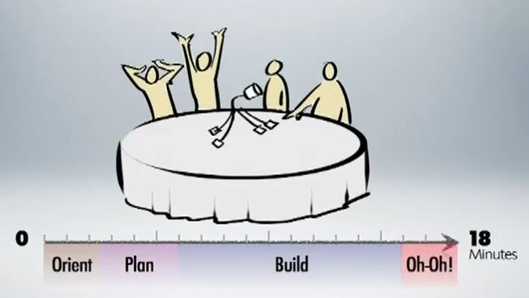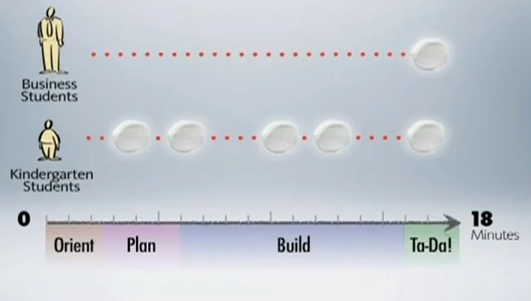It’s amazing what you can learn from a marshmallow. It can even cause you to rethink and redesign your multi-million five-year major organizational change program.
A few weeks ago I attended a workshop on project management where we were drawn into an experiment involving 20 sticks of spaghetti, one yard of tape, one yard of string and one marshmallow. The objective was to build a structure as high as possible and the marshmallow needed to be on top.
The Marshmallow Challenge
You may be curious about what this possibly has to do with project management. Turns out that this challenge reveals all of the things that are essential and that you won’t find in the books and methodologies on project management. The ‘marshmallow challenge is a popular challenge. Designer Tom Wujec even created a website on the topic and conducted some research on the performance of marshmallow construction teams. The thing got more attention since he talked about the results on TED last year.
The Uh-Oh Moment
The biggest surprise always comes from the weight of the marshmallow. Although the weight of the marshmallow is known from the start, the majority of the project teams wait until the very last moment to put it on top. This is the biggest flaw of all projects and it gets even worse when the level of education of the participants is higher (in fact: kindergarten graduates outperform other teams on this challenge!). Here is what typically happens as the project unfolds in a team of very skilled people:
- In the orientation phase there is some power play and who-does-what gets decided upon;
- Skilled teams are trained to create a single best plan;
- They consume most of the time by building the structure according to the plan;
- When the time is almost up, they take out the marshmallow and put it on top;
- For a very brief moment you hear ‘ta-da’, and then it is most of the times ‘uh-oh’.
From Uh-Oh to Ta-Da!
So far so good. We were about 20 minutes into the workshop, played around with some spaghetti and built a structure that did not work. Obviously, the next step is to blame the marshmallow. That’s what we do in real projects, right? The target population and their needs (the marshmallow for organizational change management projects) are known from the outset, and yet we never start building with them in mind. We always build with the one single plan in mind; a plan that is based on assumptions.
Looking at kindergarten graduates, here is how we can improve our performance on the challenge: kids always start with the marshmallow and they build one prototype after the other. Designers call this the ‘iterative process’: constantly prototyping and refining.
This results in an entirely different use of the time, and for change management projects this would also result in an entirely different relationship with the target population, because it requires you to involve the target population from the outset. The point is to keep the marshmallow on top from the very beginning!
By the way, you may have noted that this is what I am proclaiming when I talk about raising the bar for our profession (only now it gets even more clear that early involvement and ownership is essential)
What’s In It For Us?
The marshmallow challenge was a real eye-opener for me and the take-aways are very enriching. I can summarize them by quoting Tom Wujec:
Every project has its marshmallow.
Design truly is a contact sport. It demands that we apply the very best of our thinking, feeling and doing to the challenge that we have at hand.
Sometimes a little prototyping is what it takes to turn a Uh-Oh project into a Ta-da project.
Finally, I’d like to thank Katia Van Belle who is an extremely skilled and knowledgable facilitator for this exercise.



